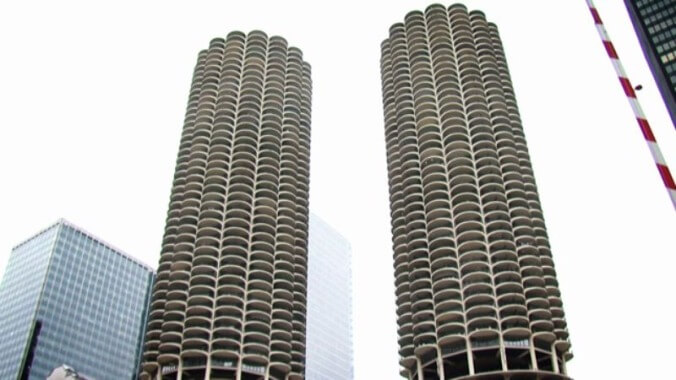Chicago: The Wilco towers
Art has a powerful way of re-contextualizing the mundane. Take, for example, the towers pictured on the cover of Wilco’s much-lauded 2002 album, Yankee Hotel Foxtrot. These are buildings hundreds of thousands of people in Chicago see on a daily basis without giving them a second thought. As much as the buildings’ unique design sticks out in the city’s skyline, after a while, you just stop noticing.
Wilco frontman Jeff Tweedy and the band’s longtime graphic designer, Lawrence Azerrad (cousin of author Michael), were struggling with the design for Yankee Hotel Foxtrot. They wanted something that connected the band to its hometown, so they combed through hundreds of photos shot by Sam Jones (who would later release a film about the album called I Am Trying To Break Your Heart). Nothing was working until they saw a picture of Marina City. Azerrad removed the neighboring buildings from the image to keep focus on the towers, and Yankee Hotel Foxtrot had its cover. Paste ranked it number 18 in its list of the decade’s 25 best album covers, and nearly 10 years after the album’s release, Marina City is still called “the Wilco towers” by fans.
Architect Bertrand Goldberg was rebelling against the boxy skyscraper that had been born in Chicago 80 years before Marina City opened in 1962. A few years later, a much more traditional building would be constructed across the street by Goldberg’s mentor, Mies “Boxy Skyscraper” van der Rohe. (That’s the IBM building at 330 N. Wabash Ave.) “Mies did not understand that I was building Marina City with the same logic as his boxes but discovering another space and economy,” Goldberg said in a 1985 interview. “I was revolting against an era of static space, against the straight line, against the idea of man made in the image of the machine.”
The towers combined residences with businesses at street level for the first “mixed-use” development. Goldberg wanted Marina City to be a self-contained “city within a city,” which he hoped would help revitalize the area. “An error in thinking has led Americans to turn our downtown city areas into canyons of glass and steel, teeming with office workers during weekdays but deserted nights and weekends,” Goldberg wrote in the Chicago Daily Tribune in 1961. He later said that Marina City was his attempt “to modify society through architecture.”
He succeeded on at least some levels—mixed-use developments are ubiquitous 40 years later, and the ideas Goldberg brought to the design of Marina City have been hailed as decades ahead of their time. It’s deep stuff considering Tweedy and Azerrad just needed a cool photo.
The buildings have popped up in many TV shows and films over the years, and the condo board at Marina City has been especially vigilant about protecting its image. A few years back, it tried to claim it has a “common law copyright” protecting the use of the building’s image, meaning you had to get permission to take pictures. The claim was widely mocked for its shaky understanding of copyright law. (Wilco didn’t get permission to use the image for Yankee Hotel Foxtrot.)
Aside from the cover of Yankee Hotel Foxtrot, Marina City is best known for a stunt from Steve McQueen’s last film, 1980’s The Hunter, when a car launched off the parking garage and into the Chicago River. It was repeated in a 2006 commercial for Allstate, and Michael Bay apparently was planning to top it while destroying Chicago in Transformers: Dark Of The Moon.
According to a report in Marina City Online, Bay planned to send four flaming cars off the parking garage and into the river. But it didn’t happen, either because Bay didn’t have enough time, or because he thought the buildings’ $40,000 location fee was too steep.
Well, no one wants to call Marina City “Transformers Towers,” so it’s all for the best. We’ll stick with Wilco Towers.
